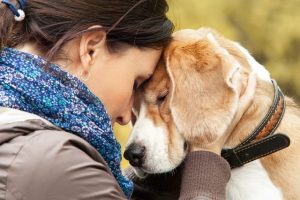
“Dogs come into our lives to teach us about love, they depart to teach us about loss. A new dog never replaces an old dog, it merely expands the heart. If you have loved many dogs your heart is very big.” – Erica Jong
Consider this post a love letter to everyone out there who has grieved over the loss of a dog or pet. Our dogs are often with us through many major life changes and transitions, bearing witness to all the happy and unhappy seasons of our lives. My dogs have been with me through divorce, remarriage, and the adoption of two children — lots of adjustments for all of us — and have been steady and constant throughout. But with so much shared experience, it can be a huge and even overwhelming loss when such beloved companions pass away. Today we’re going to discuss how to take care of ourselves when we’re going through such a devastatingly tough time.
One thing for certain.. there is one upside of losing a dog. Loss creates empathy, and we gain the ability to be even more compassionate. Losing a dog is heart-wrenching, but it is incredibly comforting to have the support of other people who know what’s it’s like to lose a four-legged friend. I’ve listed ways below to support friends and family through loss as well.
Taking care of yourself…
First, give yourself time. Give yourself time to grieve and be sad without feeling the pressure to just get over it. As Michael Zadoorian wrote about losing his cat, “We feel what we feel. Grief is involuntary. Grief has no proportion to weight or size, genus or gender.”
In her posts Love, Guilt, and Putting a Dog Down and Helping a Dog Through a Loss (more on that later), Patricia McConnell writes that she had learned “that ‘social distress,’ or what we’d call grieving, is registered in a primitive part of the brain that is also associated with the perception of pain.” She goes on to kindly add “And so, remember that when you lose a dog, or if you are still grieving for one you lost in the past, your body thinks you’ve been injured. It needs you to take care of yourself. It needs rest and comfort and flowers and sweet soup and gentle kisses and hugs.”
“I feel about my dogs now, and all the dogs I had prior to this, the way I feel about children—they are that important to me. When I have lost a dog I have gone into a mourning period that lasted for months.” – Mary Tyler Moore
Second, give yourself space, the emotional space to express your feelings. Not everyone out there is a dog lover, but if you have like-minded friends or family members, confide to them how you feel. If not, find an online support group or call a pet loss hotline. Both Tufts University Cummings School of Veterinary Medicine and Cornell University College of Veterinary Medicine have support hotlines for pet owners. Remember that it’s not uncommon to feel a range of emotions including guilt, denial, anger, and depression. For example, if your dog suffered from a terminal illness while still relatively young, you may feel that you should have handled the illness in another way. We all do the best we can do with the information we have in the moment. Above all else, remember that you will come out on the other side.
Last, if you find it comforting, create a plan to memorialize your dog. You may want to donate to a cause, rescue group, or animal shelter in his or her name. You may want to create a special burial marker, or if you’ve had your dog cremated, scatter the remains or keep the urn in an honored spot with your dog’s picture.
Caring for Others…
As mentioned above, memorializing a lost dog or pet can provide some measure of comfort. It validates that the dog was truly important in that person’s life, not just a pet. Donating to a cause in your friend or family member’s name (or in their pet’s name), can be a way to show how much you care about them and their feelings.
Memorials can also take the form of pictures and even paintings. I’ve been fortunate enough to receive both. My close friend and fellow trainer Heather Moore arranged to have professional pictures taken of my Rottie Frances when she was ill with bone cancer. Years later, I still have that reminder of Frances, and of Heather’s kindness, on my wall. Another generous friend Michelle asked me to email a picture and had a small oil painting created of my Dalmatian Puck. Both of these images will always mean the world to me.
If you have a child or children dealing with a dog or pet’s loss, review these age-related suggestions from the Association of Pet Loss and Bereavement (APLB). You may want to create a ceremony for celebrating their dog’s life and remembering sweet and funny things that their dog did (see The Tenth Good Thing About Barney), help them create drawings or paintings about their dog, put together a scrapbook, or even plant a tree in memory of their dog. Great books can also help a child to process their dog’s death. Do keep in mind that the loss of a pet is often the first death that a child experiences.
Finally, if you have other dogs or pets, be ready for their mourning period too. Some dogs grieve very little while others grieve intensely. Your remaining dog may lose his appetite, lack energy or sleep longer than usual, be anxious when left alone resulting in destructive behavior, accidents, or barking/howling, and seem depressed. If symptoms last longer than a few days or a couple of weeks, get in touch with your veterinarian.
I’ll leave you with this…
“There’s a stone I had made for Luke at the top of the hill road, where the pasture opens wide and the setting sun highlights the words carved into its face. ‘That’ll do, Luke, that’ll do.’ The words are said to working dogs all over the world when the chores are done and the flock is settled: ‘That’ll do dog, come home now, your work is done.’ Luke’s work is done too. He took my heart and ran with it, and he’s running still, fast and strong, a piece of my heart bound up with his, forever.” – Patricia McConnell For the Love of a Dog
By Susan Marett










